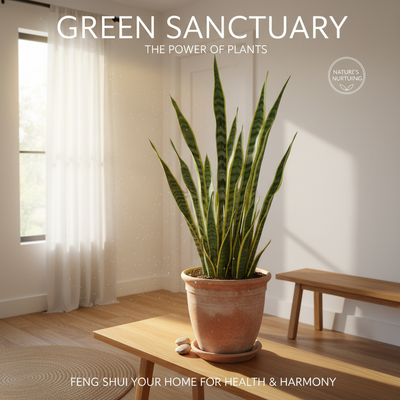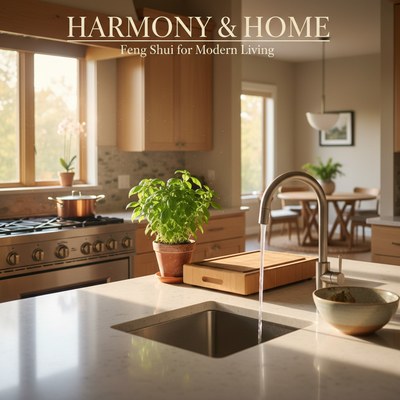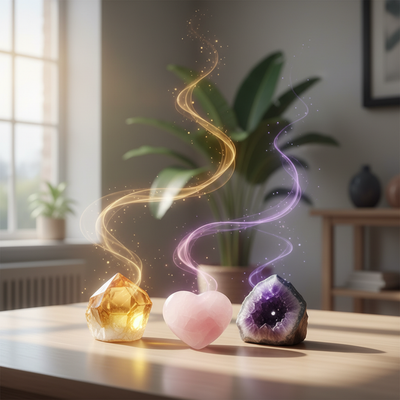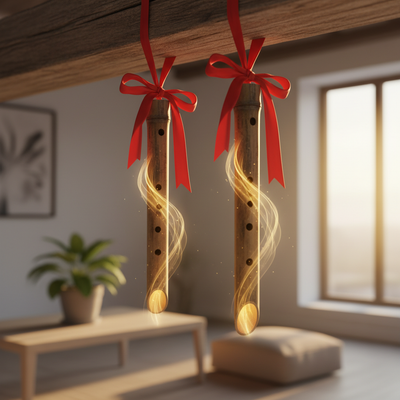Getting Started with Small Spaces

Everyone wants a calm, peaceful bedroom. It's our safe place, where we rest, recharge, and start each new day. But when you don't have much space, creating that peaceful spot can feel like solving a difficult puzzle. The walls seem too close, the furniture too big, and having "good energy flow" feels like something only people with big houses can have.
Here's the truth: a small room can definitely have great Feng Shui. Actually, having less space makes you think more carefully about your choices, which is exactly what this ancient practice is all about. This guide is made just for you. We will explain the basic ideas and give you a clear, step-by-step plan to change your small bedroom.
We will talk about the basic rules you need to know, a detailed layout guide made for tight spaces, how to solve common small-room problems, and advanced tips to improve your space. By the end, you will feel confident about arranging your room for better sleep, less stress, and lots of positive energy, proving that good Feng Shui isn't about size, but about being thoughtful.
Basic Feng Shui Rules
To arrange your space well, you need to understand the "why" behind the rules. Feng Shui is not just random decorating commands; it's the art and science of working with your space to make your life better. At its heart are a few key ideas that are especially important for the bedroom.
The main goal is to build and balance Chi (or Qi). Think of Chi as the life force energy that flows through everything, including your home. In a room, you can feel its quality. Is the energy bright, light, and flowing, or is it stuck, heavy, and trapped? A well-designed Feng Shui bedroom makes sure that Chi can move freely, feeding you while you sleep.
-
Chi (Qi): The invisible life force energy. The goal in Feng Shui is to encourage a smooth, gentle flow of positive Chi throughout your space, much like a gentle breeze, rather than a harsh wind or still air. In a small bedroom, preventing stuck Chi is very important.
-
The Commanding Position: This is the most important rule for your bedroom. It decides where to put your bed compared to the door. To be in the commanding position, you should be able to see the door from your bed without being directly in line with it. This placement uses our natural instincts for safety and security, letting your nervous system fully relax. When you feel safe, you sleep better.
While you may have heard of the Bagua Map, an energy map placed over your home's floor plan, using it strictly can be hard and frustrating in a single, small room. For a feng shui bedroom layout small room, we find it much better to focus on the basic rules: mastering the commanding position, making sure Chi flows freely, and clearing clutter.
The Small Room Problem
Here is the reality for most people with small bedrooms: the "perfect" Feng Shui rules don't work with the physical limits of the space. You read that you shouldn't put your bed under a window, but it's the only wall long enough. You're told not to have the bed in line with the door, but the room's shape gives you no other choice. This is where many people give up, but it's actually where true Feng Shui begins.
The practice is about creating the best possible energy within your given situation, not about reaching an impossible standard of perfection. To handle this, we use a "Good, Better, Best" system for making decisions.
- Best: The bed is in a perfect commanding position against a solid wall, with space on both sides.
- Better: The bed is in a less-than-perfect position, but you use a Feng Shui "cure" or adjustment to reduce the negative effect.
- Good: The bed placement can't be changed and isn't ideal, so you focus on making every other part of the room stronger—perfect decluttering, great color choices, and balanced elements—to make up for it and lift the room's overall energy.
Using this mindset helps you work with your room, not against it. It's about practical solutions, not strict rules. Here are some of the most common challenges and their real-world solutions.
| Common Small Room Problem | "Perfect" Feng Shui Rule | Practical Solution |
|---|---|---|
| Bed must be placed under a window | Avoid beds under windows | Use a very strong, solid headboard to create a sense of support and hang thick, grounding curtains you close at night. |
| Door opens directly onto the bed | Bed should not be in line with the door | Hang a multi-sided crystal ball from the ceiling halfway between the foot of the bed and the door to spread out the Chi. |
| No space for two nightstands | Have balanced nightstands on both sides | Use a small floating shelf or a wall-mounted light on the tighter side. Balance can be created in other ways. |
| Bed must be pushed into a corner | Allow Chi to flow around both sides of the bed | If you are single, this is okay. If in a relationship, try to leave even a few inches of space to walk through. |
Your Step-by-Step Layout Guide
Now we move from ideas to action. This section gives you a detailed, step-by-step process for using these rules to create the best feng shui bedroom layout small room. Follow these steps to carefully transform your space.
Step 1: The Bed is Most Important
Your bed is the most important piece of furniture in the room, as it is energetically connected to you for a third of your life. Where you put it and what it's like are the foundation of good bedroom Feng Shui.
First, find the best possible commanding position. Stand in your doorway and look at the wall farthest from you and diagonal to the door. This is usually the perfect spot. You want to be able to see the door without your feet pointing directly out of it. This lets you feel in control of your space and naturally relax.
Next, focus on the headboard. A solid, strong headboard is absolutely necessary, especially in a small room. It gives you a sense of stability and support for your head and body while you sleep. This is twice as important if your only option is to put the bed against a wall with a window. The headboard acts like a symbolic mountain, grounding your energy. Choose a solid wood or padded headboard over one with bars or slats, which can create a feeling of being trapped.
Finally, think about the bed frame itself. To let Chi flow and move freely around you as you rest, it's best to have a bed frame that is raised off the floor with open space underneath. While storage beds are tempting in a small room, they can create stuck energy right below your body. If you must use one, be very organized. Only store soft items like sheets and off-season clothing, and keep them perfectly neat and tidy.
Step 2: Clear Clutter for Clarity
If you only do one thing to improve your room's Feng Shui, let it be clearing clutter. Clutter is the physical form of stuck, stagnant energy. It drains your energy, creates mental fog, and stops positive new energy from entering your life. In a small bedroom, the effect of clutter is stronger, making the space feel heavy and chaotic.
Start with a focused action plan. Handle one area at a time to avoid feeling overwhelmed.
- Under the Bed: If you have space under your bed, it must be completely clear. This is the area where energy needs to move to refresh you during sleep. Storing items here, especially those with emotional baggage or chaotic energy (like old papers, shoes, or exercise equipment), directly affects your subconscious.
- The Closet: A cluttered closet represents hidden problems and opportunities you aren't dealing with. Be honest about what you wear and what you love. If items are broken, don't fit, or carry negative memories, let them go. A well-organized closet creates a sense of control and clarity every time you open the door.
- Surfaces: Nightstands, dressers, and shelves should be kept as clear as possible. Limit items to the absolute essentials: a lamp, a book, a small glass of water. Every object holds energy; make sure the ones you see last at night and first in the morning are calming and beautiful.
In our work, our experience at THE QI FLOW shows that clearing clutter is always the most powerful first step in client transformations. Before we even move a single piece of furniture, a thorough decluttering session can make a room feel lighter, larger, and more breathable, leading to immediate reports of better sleep and less anxiety.
Step 3: Color and Elements
Color has a strong effect on our mood and energy levels. In a small bedroom, color works on two levels: it influences the room's Chi and affects how big the space feels.
For most of your walls and large furniture, use a palette of soothing, neutral colors. Feng Shui often recommends "skin tones"—a range from soft whites and creams to warm beiges, gentle tans, and blush pinks. These colors are naturally calming and restful. They also have the added benefit of making a small space feel more open and airy by reflecting light.
This doesn't mean your room has to be boring. You can add accent colors strategically, using the principles of the Five Elements to bring in specific energies you want to create.
- Earth: For stability and self-care (creams, tans, soft yellows).
- Metal: For precision and clarity (whites, grays, metallics).
- Water: For wisdom and flow (deep blues, black).
- Wood: For growth and vitality (greens, browns).
- Fire: For passion and recognition (reds, bright oranges, purples).
In a small room, use these accent colors in small amounts: through pillows, a throw blanket, a piece of art, or a small vase. A touch of green (Wood) can promote healing, while a hint of blue (Water) can support your career path.
The connection between color and rest is also backed by research. For instance, a well-known study by Travelodge surveyed thousands of households and found that bedrooms painted in calm colors like blue, yellow, and green were most helpful for rest, with participants sleeping the longest in these environments.
Step 4: Mirrors with Care
Mirrors are a powerful tool in Feng Shui, and in a small room, they are often used to make the space feel larger. However, in the bedroom, they must be used very carefully.
The main rule is this: a mirror should never reflect the bed. From a Feng Shui perspective, a mirror reflecting the bed is thought to double the energy in the room, which can be disruptive to sleep. It's like having an extra person or set of activities in your restful space. For couples, it is sometimes said to invite the energy of a third party into the relationship, potentially leading to problems. Whether you believe the symbolism or not, many people report feeling unsettled or that their sleep is less deep when a mirror faces their bed.
This doesn't mean you must get rid of mirrors completely. They can be wonderful for making light brighter and creating a sense of depth. The key is placement. A great solution for a small room is to place a mirror on the inside of a closet door. This way, it's available when you need it but is closed away while you sleep. You can also place a mirror on a wall that reflects a window, which effectively doubles the natural light and brings the positive energy of the outdoors inside, without reflecting you in your bed.
Step 5: Balance and Symmetry
The principle of balance in the bedroom is important, especially for promoting harmony in relationships or attracting a partner. The ideal setup is perfect symmetry: a bed centered on a wall with two matching nightstands and two matching lamps.
In a small room, this is often not possible. But balance is not just about perfect mirroring. It's about creating a feeling of equilibrium. If you only have space for a nightstand on one side of the bed, create visual balance on the other side. This could be a tall, slim floor lamp, a small stack of books on the floor, or a piece of art hung at nightstand height. The goal is that both sides of the bed feel equally weighted and important.

This principle extends to other items in the room. Whenever possible, choose items in pairs. Two pillows instead of one, two matching candles on a dresser, or artwork that features a pair of something (two trees, two birds, two people). This subtly reinforces the energy of partnership and equality, creating a welcoming space for both you and a current or future partner. Even if you are single and happy, this sense of balance creates a feeling of wholeness and self-sufficiency.
A Real-World Change
Theoretical advice is helpful, but seeing it in action provides true clarity. We want to share a story from our work that perfectly shows how to apply these principles to a challenging feng shui bedroom layout small room.
The Challenge: We were contacted by a client, "Sarah," a young professional living in a small city apartment. Her bedroom was tiny and served as a storage space for everything that didn't fit elsewhere. She complained of chronic poor sleep, waking up exhausted, and feeling "stuck" in her career. Her bed was pushed into a corner against a window, and her feet pointed directly at the door—a combination of several Feng Shui problems.
The Process (Our Approach): The THE QI FLOW team began with an energy assessment. We identified three main blocks. First, the bed placement created a constant sense of vulnerability, preventing deep rest. Second, the significant clutter under and around the bed was creating heavy, stagnant Chi. Third, a single, harsh overhead light fixture created oppressive energy.
The Solution: We implemented a series of practical, budget-friendly changes.
1. We moved the bed to the opposite wall. It wasn't a "perfect" commanding position, but it was much better. It was now diagonal to the door, giving her a clear view without being in the direct path of incoming energy.
2. We installed a solid, padded headboard to create a strong sense of support, reducing the problem of the wall having a small, off-center window.
3. We guided Sarah through a major decluttering session, clearing everything from under the bed and organizing her closet. We advised her to only keep items in the bedroom that related to rest and romance.
4. We replaced the harsh overhead light with a dimmer switch and added a soft lamp on her nightstand, creating layered, gentle lighting. As she had no space for a second nightstand, we installed a small floating shelf on the other side with a tiny plant to create balance.
The Result: The transformation was amazing. Within a week, Sarah reported sleeping through the night for the first time in months. She said she woke up feeling "clear and light" instead of groggy. Two months later, she called to tell us she had successfully pitched a major project at work, attributing her newfound confidence and clarity to the renewed energy in her personal sanctuary. This demonstrates that even small, thoughtful changes can have a massive, positive ripple effect on your entire life.
Common Mistakes to Avoid
As you rearrange your room, it's just as important to know what to avoid as what to do. Stay away from these common mistakes that can accidentally create negative energy in your small bedroom.
- DO NOT sleep under a heavy beam or slanted ceiling. These architectural features create a heavy, oppressive energy that can feel like a weight on you while you sleep, leading to pressure and restlessness. If you cannot move your bed, you can symbolically lift the energy by painting the beam the same color as the ceiling or hanging a light piece of fabric from it.
- DO NOT keep electronics near the bed. Laptops, tablets, and phones emit EMFs (electromagnetic fields) and blue light that are known to disrupt sleep patterns. The bedroom should be a low-tech zone. At a minimum, keep all electronics at least three feet away from your head while you sleep.
- DO NOT have dead or dying plants in the room. Plants represent Wood energy, which is about growth and vitality. A dying plant represents the opposite—decaying energy—which has no place in a room for renewal. Choose healthy, thriving plants or have no plants at all.
- DO NOT store things under your bed. We are repeating this because it is critical. This area must remain open to allow Chi to circulate and refresh your personal energy field while you rest. The only exception is for soft, clean linens.
- DO NOT face a sharp corner ("Poison Arrow"). A sharp corner from a piece of furniture (like a dresser or bookshelf) or a structural wall pointing at you while you sleep acts as a "poison arrow," directing cutting, aggressive energy towards you. Either move the furniture or soften the corner by placing a plant or draping fabric over it.
Making Your Space Better
Once you have the layout, decluttering, and core principles handled, you can add another layer of improvement to truly make your bedroom a high-energy sanctuary. These advanced touches fine-tune the room's energy.
- Artwork: The art in your bedroom should be inspiring, peaceful, and uplifting. Avoid images that are sad, lonely, or chaotic. Landscapes, beautiful abstracts, or inspiring quotes are excellent choices. If you are in a relationship or wish to be, choose artwork that features pairs—two flowers, two trees, two people—to reinforce the energy of partnership.
- Lighting: Good lighting can completely change a room's feel. Avoid relying on a single, harsh overhead light. Instead, create layered lighting. You need a main ambient light (ideally on a dimmer switch), and softer task lights like bedside lamps for reading. The ability to control the light level allows you to transition the room's energy from active to restful.
- Plants: While you should avoid having too many plants in your bedroom, a single, well-chosen plant can be helpful. Certain plants, like the Snake Plant or Peace Lily, are known for their air-cleaning qualities and release oxygen at night. Place the plant across the room from your bed, not right next to it, to ensure its active Wood energy doesn't disrupt your rest.
- Aromatherapy: Scent is a powerful way to shift energy. Use a high-quality essential oil diffuser with calming scents to cleanse the space and prepare it for sleep. Lavender is well-known for its relaxing properties, while chamomile can soothe anxiety. Frankincense is excellent for clearing stagnant energy. Use these scents thoughtfully, perhaps as part of a bedtime routine.
Your Small Room, Your Sanctuary
Creating a successful feng shui bedroom layout small room is not about following an impossible set of rules. It is a creative and personal process of working with the space you have to create the best possible energy flow for your well-being. It's about intention, practicality, and making thoughtful choices.
Your bedroom, no matter its size, holds the potential to be a powerful sanctuary. It is the place that should support your health, your dreams, and your relationships above all others. By using these principles, you are not just decorating; you are actively shaping your environment to nurture and restore you.
Don't feel you need to do everything at once. Start with one small change—clear the clutter from under your bed or buy a solid headboard. Experience the subtle shift in how the room feels, and let that positive momentum inspire your next step. Your peaceful sanctuary is waiting.







